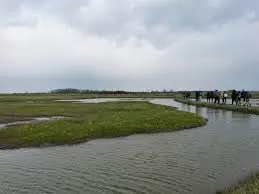
Environment and Biodiversity
Place
Mouëze, France
Sponsor
Patrice Alary
Grant(s)
€10,000 to the Selection Committee at 2013/12/10
Project leader
Founded in 1912 and recognized of community interest in 1986, Ligue pour la Protection des Oiseaux (LPO), with its 46,000 members, acts daily to protect the biodiversity. Its activities are hinged on three missions: protection of the species; conservation of the spaces; and awareness-raising. LPO accordingly, alongside Conservatoire naturel du Littoral, manages the Moëze-Oléron national nature reserve (220 hectares on shore, 6500 offshore) whose long-term objective is the "conservation of the biodiversity of an ecosystem characteristic of a Centre-Atlantique estuarine tidal marsh".
270 bird species have been observed on the site, the largest contingent being the wintering or migratory water birds. The nature reserve actually occupies a strategic position, located on the major Atlantic migratory route, between the north Palearctic where many species nest and west Africa, where many of them winter.
Wealth of the fauna in danger
Besides the birds, the reserve has freshwater fish, amphibians, reptiles and mammals, including the European otter, the water shrew, and even the bottlenose dolphin. The management of the levels and water inputs/drainages for "biodiversity" purposes is feasible thanks to some 40 hydraulic structures (lock, cofferdam, valve, electric pump), the latest of which were installed over 10 years ago. Today, however, half of these structures require an overhaul, adjustment, or even replacement, the better to meet the conservation objectives for the heritage fauna and flora characteristic of these habitats.
As the contracting authority, LPO has therefore decided, as part of its management plan, to initiate a major program to renovate these structures, by seeking financial backers among the public and private partners and by subcontracting the work to specialized firms. The seasonal conditions for carrying out this work program are optimal in August and September: the reproduction of the water birds is virtually complete, the other groups of aquatic fauna have not yet begun their "siltation" winter cycle, and the major reproduction cycles of the fish are terminated. The field operations are therefore planned in August and September 2014 and 2015.
The Foundation is supporting the renovation of the hydraulic structures.

